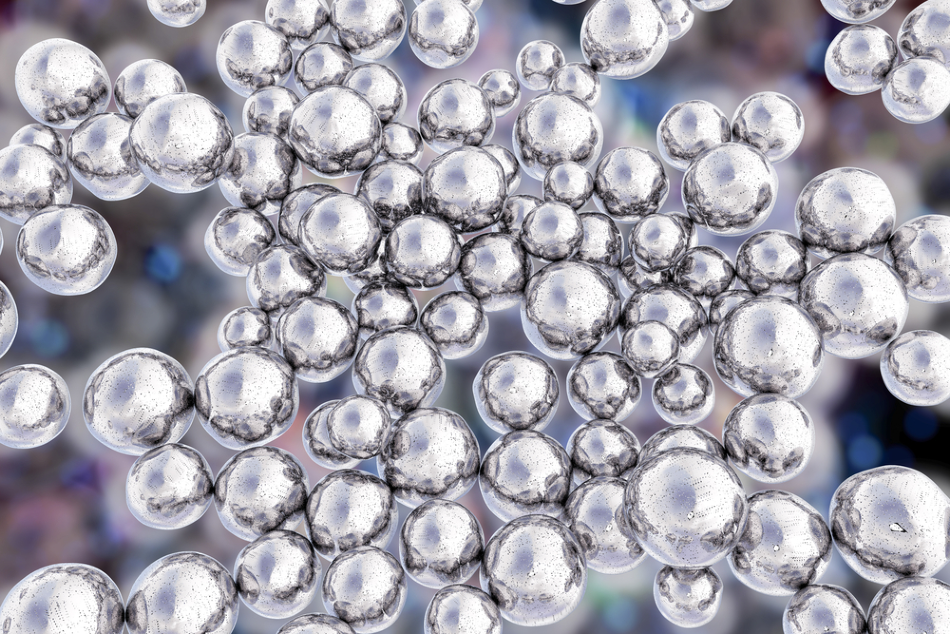
Image Credit: Kateryna Kon/Shutterstock.com
Silver is a well-known antimicrobial and antibacterial agent, and is most commonly used in its bulk forms as silver ions or silver salts. However, because nanoforms are known to be more active than their bulk counterparts, silver nanoparticles have been trialed in several commercial products, and are showing a great deal of promise.
There is also a need to find new methods to combat microbes as bacteria are becoming increasingly resistant to conventional antimicrobial products. Using silver nanoparticles is one of these new methods.
It is thought that silver nanoparticles are effective because they can adhere to the outer membrane of the microbe, and then produce reactive oxygen species (ROS) and free radical species after penetrating the membrane. This subsequently interferes with the signaling pathways of the microbes, causing their basic function to be disrupted.
While the effects of silver nanoparticles on microbes are well-known, the exact mechanisms are not.
The exact mechanism by which the nanoparticle adheres to the outer membrane of the microbe is not yet known, although it is thought that lipopolysaccharide molecules and membrane proteins cause irregularities in the outer membrane, changing its permeability.
The exact mechanism for free radical formation and cellular degradation is also not entirely known, though one of the most common theories is that free radicals form on the surface of the nanoparticles in an uncontrolled manner. The free radicals then permeate through the pores of the microbe’s membrane and attack the lipids within the membrane. This, in turn, causes the membrane to break down, causing the microbe to die.
There are many different factors that affect the physiochemical principles of the silver nanoparticles—such as size, shape, surface charge, concentration and colloidal state—which in turn affect how effective it is at killing microbes. Silver nanoparticles are less reactive than silver ions, making them potentially suitable for therapeutic applications against multi-drug resistant bacteria, as well as in different antimicrobial surfaces.
As it stands, many different microbes can be disrupted by silver nanoparticles by either reducing their ability to multiply or by destroying them, including harmful bacteria such as E. Coli. More evidence will likely be found on how silver nanoparticles affect different microbes in future research.
Effects on Human Health
Ensuring the use of silver nanoparticles in the long-term is reliant on them being safe as consumer products. Therefore they need to not only be effective against microbes, but they need to be ineffective in human cells.
Silver nanoparticles are widely used in packaging applications, including food and paints, across the US and many countries within Asia. Even though they are used in everything from food wrap to baby bottles, there is still some ambiguity regarding their toxicity to humans.
Studies show that the effects on the body range from nil to moderate toxicity, and the migration studies from where they are embedded also show differing results. It is thought that silver nanoparticles may have a low accumulation rate, and may only be toxic at high concentrations. More evidence is needed to be conclusive, while they will likely continue to be used as antimicrobial and antibacterial agents in the foreseeable future.
References and Further Reading
Martirosyan A. and Schneider Y-J. (2014) Engineered Nanomaterials in Food: Implications for Food Safety and Consumer Health, Int. J. Environ. Res. Public Health DOI: 10.3390/ijerph110605720
McClements D. J. and Xiao H. (2017) Is nano safe in foods? Establishing the factors impacting the gastrointestinal fate and toxicity of organic and inorganic food-grade nanoparticles. npj Science of Food DOI: 10.1038/s41538-017-0005-1
Dakal T. C. et al (2016) Mechanistic Basis of Antimicrobial Actions of Silver Nanoparticles Frontiers in Microbiology https://doi.org/10.3389/fmicb.2016.01831
Kim J-S. et al (2017) Antimicrobial effects of silver nanoparticles Nanomedicine: Nanotechnology, Biology and Medicine DOI: 10.1016/j.nano.2006.12.001
Disclaimer: The views expressed here are those of the author expressed in their private capacity and do not necessarily represent the views of AZoM.com Limited T/A AZoNetwork the owner and operator of this website. This disclaimer forms part of the Terms and conditions of use of this website.